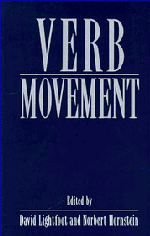Book contents
- Frontmatter
- Contents
- List of contributors
- Preface
- Verb movement: an introduction
- 1 Verb positions: evidence from Italian
- 2 Verb movement and word order in Arabic
- 3 Comments on the paper by Ouhalla
- 4 Some similarities and differences between Icelandic and Yiddish
- 5 Comments on the paper by Santorini
- 6 Finite verb movement in Scandinavian embedded clauses
- 7 Comments on the paper by Vikner
- 8 The Brythonic copula and head raising
- 9 A reinterpretation of evidence for verb movement in French
- 10 Two types of head movement in Romance
- 11 Comments on the paper by Roberts
- 12 Licensing heads
- 13 Comments on the paper by Koopman
- 14 Finiteness and head movement in early child grammars
- 15 Comments on the paper by Wexler
- References
- Index
3 - Comments on the paper by Ouhalla
Published online by Cambridge University Press: 03 May 2011
- Frontmatter
- Contents
- List of contributors
- Preface
- Verb movement: an introduction
- 1 Verb positions: evidence from Italian
- 2 Verb movement and word order in Arabic
- 3 Comments on the paper by Ouhalla
- 4 Some similarities and differences between Icelandic and Yiddish
- 5 Comments on the paper by Santorini
- 6 Finite verb movement in Scandinavian embedded clauses
- 7 Comments on the paper by Vikner
- 8 The Brythonic copula and head raising
- 9 A reinterpretation of evidence for verb movement in French
- 10 Two types of head movement in Romance
- 11 Comments on the paper by Roberts
- 12 Licensing heads
- 13 Comments on the paper by Koopman
- 14 Finiteness and head movement in early child grammars
- 15 Comments on the paper by Wexler
- References
- Index
Summary
Introduction
Ouhalla's paper illustrates nicely how the word order of Arabic can be understood if V-movement is assigned a central role in deriving it. His analysis presents Arabic as yet another case for the claim that inflectional affixes are syntactic heads in the X'-system and can function as triggers for various movement processes. On this view both subjects and objects are moved to Spec of AGR positions for reasons of agreement or Case. These conditions can be fulfilled if the verb is moved to higher functional heads, such as Tense and AGR, to lexically support them.
My comments are directed at the success of a number of assumptions and claims in Ouhalla's paper, not just to derive from Arabic a plausible argument for the view that functional categories are triggers for various movement processes, but also a convincing one. These comments will focus on his general treatment of structural Case in Arabic in relation to the claim that NPs end up in Spec of AGR. Specifically, I will discuss his view of nominative Case in relation to subject-verb agreement, and suggest an alternative to his treatment of nominative as a default Case. I will then turn to the evidence, in part provided by ECM constructions, for the claim that direct objects in Arabic undergo syntactic movement to the Spec of AGRo position.
- Type
- Chapter
- Information
- Verb Movement , pp. 73 - 86Publisher: Cambridge University PressPrint publication year: 1994
- 3
- Cited by



